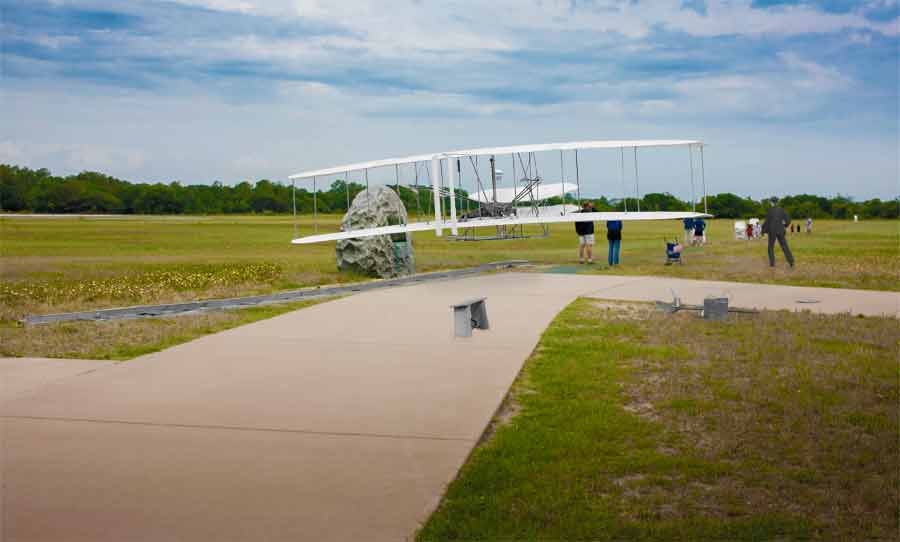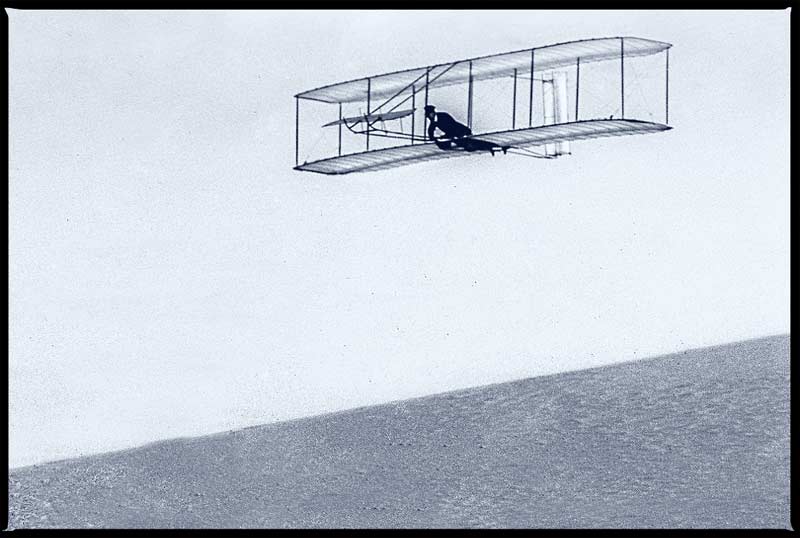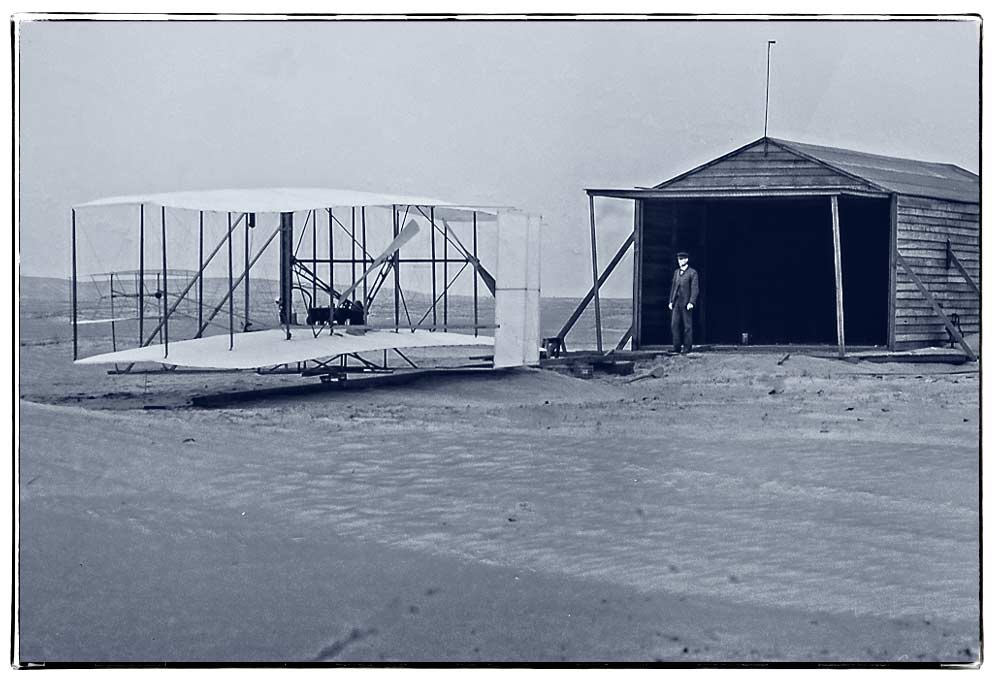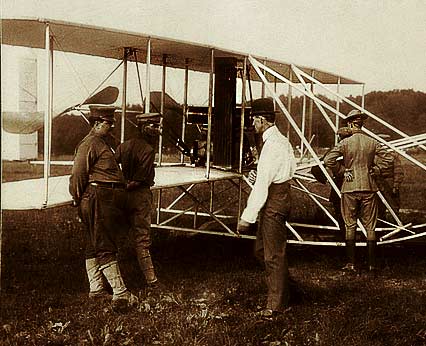Orville noted in his diary on this Thursday in December 1903, that the wind was blowing steady between 20 and 25 mph. Orville kept meticulous notes about these things and he had long ago installed an anemometer and wind directional on their workstation at Kill Devil Hills, North Carolina. On this day in 1903 the wind was coming out of the northeast. Orville could feel the icy cold and quickly lit a fire in their stove to take the chill off the air and make some coffee. It was cold, but nothing like it could get back in Dayton.
He looked outside and could see the puddles of water from yesterday’s hard rain had formed ice sheets glimmering across the flat sandy ground. The sky was mostly cloudy except for a narrow ribbon of sunlight to the west that colored everything with a pink salmon tinge for a few minutes until the clouds covered up the sun. Yesterday afternoon the brothers new that if the weather was right today, they would try the flight again. They were running out of time and they wanted to be back in Dayton for Christmas.
At the beginning of this week, they had made their first powered attempt. They had set the track launch track up further south so they were going downhill for that first test flight. With the flip of a coin Lady Luck had chosen Wilbur for that first attempt even though Orville had more time flying the gliders.

On Monday’s attempt, Wilbur laid down across the wing with the two large wood propellers spinning just a few feet on either side of him. When everything sounded good, Wilbur gave the nod and the large noisy machine began sliding along the 60 feet wood rail with Orville running beside him to steady the wing. Just before the machine reached the end of the rail, Wilbur pulled hard on the elevator control. With the head wind and the momentum from going downhill, the machine lifted quickly to 15′ and stalled.
It was a mistake and Wilbur new it right off. Wilbur tried to correct the situation by pushing the controls forward, bringing the machine back down but the angle was too steep and it crashed about 100′ from the end of the rail. Despite the extensive damage, the brothers were ecstatic. Everything had worked except for the landing. They had flown. It would take them 2 days to repair the damaged machine. This next time Orville would take the controls.
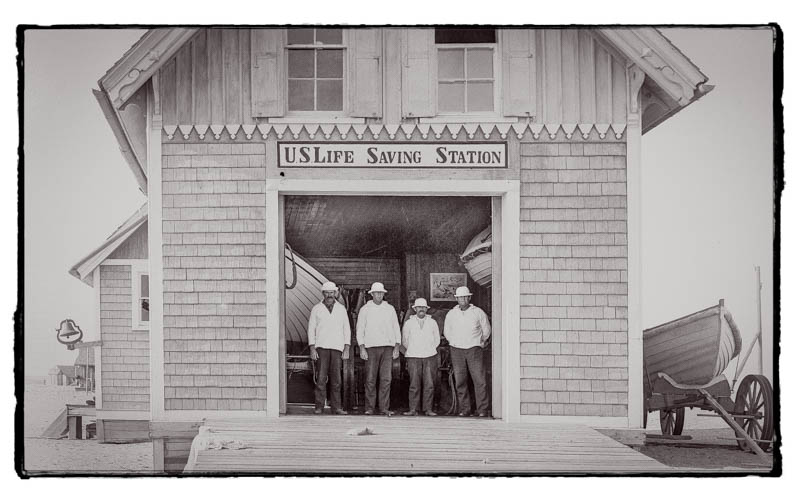
After hanging a white bed sheet on the side of the shed, the brothers went about taking on all of the last minute details. The sheet was a signal that help was needed. For years, ever since the brothers had made their way to the Outer Banks of North Carolina, the brothers had relied on the men manning the Kill Devil Hills U.S. Living Saving Station, not far from the little sparsely populated Kitty Hawk. Only five men showed up. There was John T. Daniels, Adam Etheridge and Will Dough from the life saving station and W. C. Brinkley, a farmer and salvager from Manteo on Roanoke Island. Brinkley had seen the brothers the day before getting their machine ready to make another try. He doubted they would be successful, but he decided to stay and see them try. A teenager named Johnny Moore was also present. In fact he had been present for almost every test Wilbur and Orville had done since first coming to the Outer Banks back in 1900.
Johnny Moore was 18 years old, but he had been keeping a diary of life on the Outer Banks for the last several years, which included the comings and goings of the brothers from Dayton. Twenty-two years later he would be one of the men to identify the exact spot where their fateful flight began. It would be young Johnny that ran all the way to Kitty Hawk shouting
They done it! They done it! Damn’d if they ain’t flew!”
There had been more visitors in previous attempts, but today was a particularly cold day with a stiff north wind blowing across the dunes. The brothers who grew up in Ohio were used to cold winter winds, but for folks living on the Outer Banks, today was bitter cold. This was exactly the weather the brothers wanted for their flight. In hindsight, Orville would later admit that it was foolishness that they tried to fly in that wind. But that’s what they did: FLY.
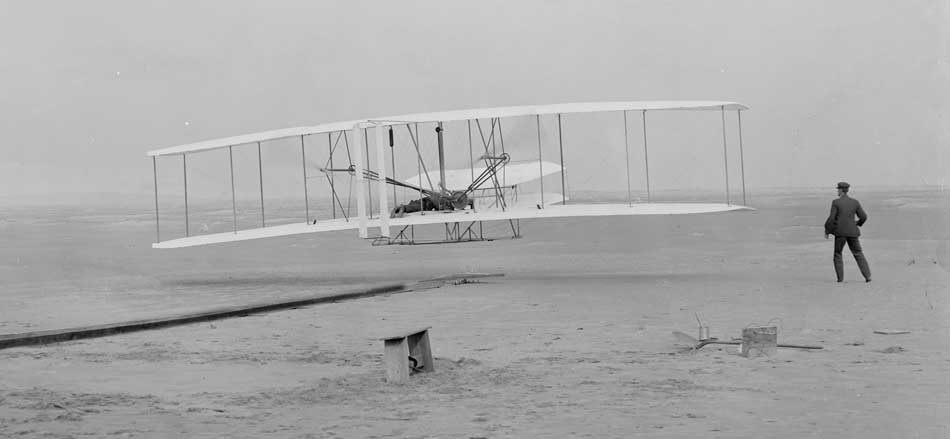
Orville took the controls first. Wilbur had setup his 5×7 Korona 5 view camera on a tripod, focusing the lens on the end of the 60′ length of 2x4s bolted together to form a single rail that ran north by northeast. The sky had become even more overcast that created the perfect light to make a photograph. Wilbur asked John Daniels to squeeze the shutter bulb when the machine reached the end of the track. That single image which wouldn’t be developed until they arrived back in Dayton, but in time it would become one of the most reproduced photographs in history.

At 10:35 A.M. Orville let go of the rope holding the machine in place. It slowly began moving forward. Wilbur began running along the tip of the right wing. Orville would later respond when asked if he was scared, “…there wasn’t time.” Daniels took the photograph just as Wilbur stopped running. The machine erratic as it was, was airborne. It would remain airborne for a total of just 12 seconds just long enough to cover about 120 feet where it came back down safely sliding across the sand coming to a safe stop.
The men picked the machine up and carried it back to the starting point then went back over to the shed to warm up. Less than a half hour later, they tried another flight. This time with Wilbur at the controls. Another successful flight this time going 175 feet. Then Orville tried a third flight and around noon Wilbur flew a fourth time reaching a distance of over 850 feet and remained in the air almost a full minute before landing safely.
They again dragged their flying machine back, but the right skid had broken so they had to take it over to the shed where repairs could be made. They were talking about the best way to quickly repair the skid so they could get another flight in before the end of the day. That decision was taken out of their hands when a sudden gust of wind lifted up the machine and it started drifting across the sand. Orville shouted to grab it, and John Daniels flung his body onto the wing just as the machine flipped over entangling him in the wires and struts. The machine began flipping end over end. Johnny Moore would later say that he feared the plane was going to roll all the way over to the beach. But the sudden gust of wind stopped and the machine came to a rest. Although Daniel was extremely bruised and scratched up, there was nothing broken. He survived. However, it would be the last time the original flying machine would take anyone off the ground.

The machine as they called it, was extremely damaged. There would be no fixing it this time. Later in the day after lunch, the brothers walked the almost 4 miles to Kitty Hawk where they sent a telegram to their father back in Dayton. It read:
SUCCESS FOUR FLIGHTS THURSDAY MORNING ALL AGAINST TWENTY MILE WIND STARTED FROM LEVEL WITH ENGINE POWER ALONE AVERAGE SPEED THROUGH AIR THIRTY ONE MILES LONGEST 57 SECONDS INFORM PRESS HOME FOR CHRISTMAS.
OREVELLE WRIGHT
_____________________________
Resources: “The Wright Brothers” by David McCullough, Library of Congress images, the Carillon Historical Park, Dayton, Ohio and Johnny Moore’s diaries.
Read more about Wilbur and Orville Wright >>
